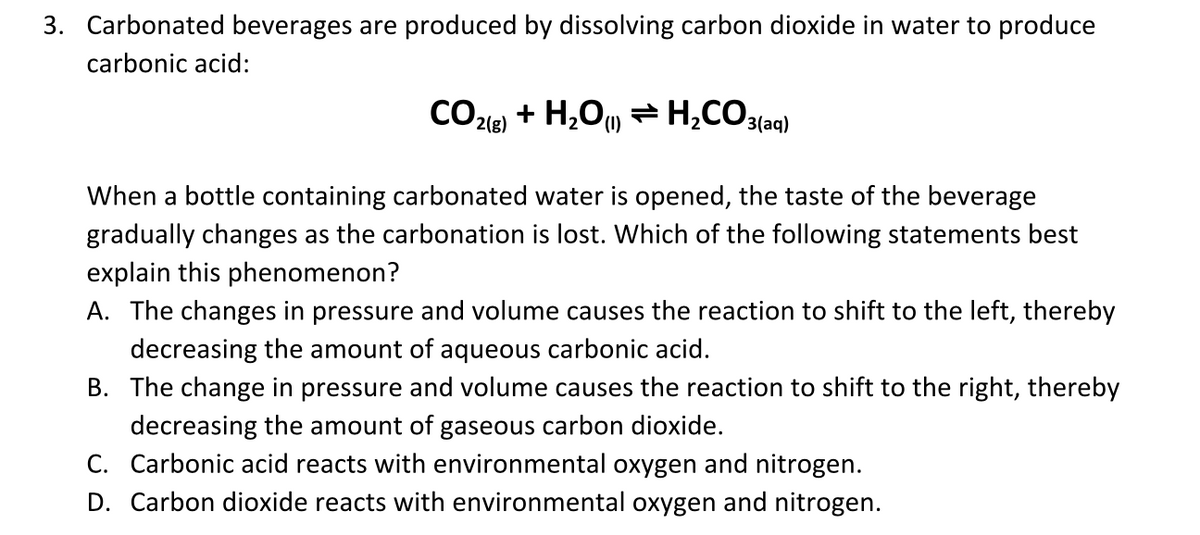Carbonated beverages are produced by dissolving carbon dioxide in water to produce carbonic acid: COle) + H,Ou H¿CO3(aq) 2(g) (1) When a bottle containing carbonated water is opened, the taste of the beverage gradually changes as the carbonation is lost. Which of the following statements best explain this phenomenon? A. The changes in pressure and volume causes the reaction to shift to the left, thereby decreasing the amount of aqueous carbonic acid. B. The change in pressure and volume causes the reaction to shift to the right, thereby decreasing the amount of gaseous carbon dioxide. onic aci C. reacts with environmental oxygen and nitrogen. D. Carbon dioxide reacts with environmental oxygen and nitrogen.
Carbonated beverages are produced by dissolving carbon dioxide in water to produce carbonic acid: COle) + H,Ou H¿CO3(aq) 2(g) (1) When a bottle containing carbonated water is opened, the taste of the beverage gradually changes as the carbonation is lost. Which of the following statements best explain this phenomenon? A. The changes in pressure and volume causes the reaction to shift to the left, thereby decreasing the amount of aqueous carbonic acid. B. The change in pressure and volume causes the reaction to shift to the right, thereby decreasing the amount of gaseous carbon dioxide. onic aci C. reacts with environmental oxygen and nitrogen. D. Carbon dioxide reacts with environmental oxygen and nitrogen.
Chemistry for Engineering Students
4th Edition
ISBN:9781337398909
Author:Lawrence S. Brown, Tom Holme
Publisher:Lawrence S. Brown, Tom Holme
Chapter12: Chemical Equilibrium
Section: Chapter Questions
Problem 12.116PAE
Related questions
Question
7, Q3

Transcribed Image Text:3. Carbonated beverages are produced by dissolving carbon dioxide in water to produce
carbonic acid:
CO23) + H,Ou H,CO3{aq)
(1)
When a bottle containing carbonated water is opened, the taste of the beverage
gradually changes as the carbonation is lost. Which of the following statements best
explain this phenomenon?
A. The changes in pressure and volume causes the reaction to shift to the left, thereby
decreasing the amount of aqueous carbonic acid.
B. The change in pressure and volume causes the reaction to shift to the right, thereby
decreasing the amount of gaseous carbon dioxide.
C. Carbonic acid reacts with environmental oxygen and nitrogen.
D. Carbon dioxide reacts with environmental oxygen and nitrogen.
Expert Solution
This question has been solved!
Explore an expertly crafted, step-by-step solution for a thorough understanding of key concepts.
Step by step
Solved in 2 steps with 2 images

Knowledge Booster
Learn more about
Need a deep-dive on the concept behind this application? Look no further. Learn more about this topic, chemistry and related others by exploring similar questions and additional content below.Recommended textbooks for you

Chemistry for Engineering Students
Chemistry
ISBN:
9781337398909
Author:
Lawrence S. Brown, Tom Holme
Publisher:
Cengage Learning

Chemistry: Principles and Practice
Chemistry
ISBN:
9780534420123
Author:
Daniel L. Reger, Scott R. Goode, David W. Ball, Edward Mercer
Publisher:
Cengage Learning

General, Organic, and Biological Chemistry
Chemistry
ISBN:
9781285853918
Author:
H. Stephen Stoker
Publisher:
Cengage Learning

Chemistry for Engineering Students
Chemistry
ISBN:
9781337398909
Author:
Lawrence S. Brown, Tom Holme
Publisher:
Cengage Learning

Chemistry: Principles and Practice
Chemistry
ISBN:
9780534420123
Author:
Daniel L. Reger, Scott R. Goode, David W. Ball, Edward Mercer
Publisher:
Cengage Learning

General, Organic, and Biological Chemistry
Chemistry
ISBN:
9781285853918
Author:
H. Stephen Stoker
Publisher:
Cengage Learning

Chemistry: Principles and Reactions
Chemistry
ISBN:
9781305079373
Author:
William L. Masterton, Cecile N. Hurley
Publisher:
Cengage Learning

Chemistry by OpenStax (2015-05-04)
Chemistry
ISBN:
9781938168390
Author:
Klaus Theopold, Richard H Langley, Paul Flowers, William R. Robinson, Mark Blaser
Publisher:
OpenStax

Chemistry: The Molecular Science
Chemistry
ISBN:
9781285199047
Author:
John W. Moore, Conrad L. Stanitski
Publisher:
Cengage Learning